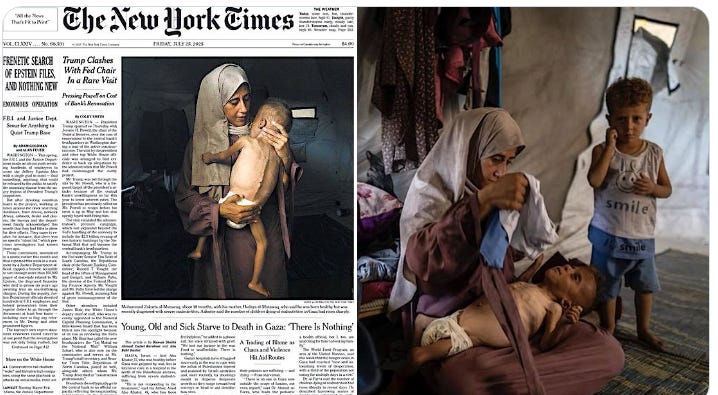The New York Times appears to have spread propaganda meant to raise fears of famine in Gaza.1
In an astonishing correction tonight, the Times said a Gaza toddler whom it had said last week suffered from malnutrition in fact had other “pre-existing health problems.”
But the vaguely worded correction does not explain a far more serious problem. As part of the article, the paper ran a huge photo that seems to show the boy is dying of malnutrition — but excluded his brother, who is clearly of normal weight.
—
(Two pictures are worth a million words.)
—
The Israeli Ministry of Foreign Affairs published the second photo on its Instagram account on Tuesday morning. Its authenticity has not been questioned. Israel also reported the boy has cerebral palsy. Children with cerebral palsy frequently have difficulty feeding themselves and appear malnourished.
In its correction, the Times neither apologized for nor explained how its reporters had failed to determine that the boy, Mohammed Zakaria al-Mutawaq, was obviously sick. Nor did it explain why the paper had chosen to run a photo that excluded his brother.
—
(The hunt for the truth never ends.)
—
The Times must now face questions that go far past the way it depicted one child.
Food deliveries in Gaza have clearly been stymied and difficult since May, when Israel shifted much of the responsibility for providing aid to a new group, the Gaza Humanitarian Foundation. But Israelis, Gazans, and aid organizations are at odds — to say the least — over whether Gaza is truly near famine, a claim that aid organizations repeatedly, and wrongly, made in 2024.
The Times article last Thursday was crucial in pushing the narrative of a true crisis of malnutrition and even starvation forward. It led me to write my own piece, headlined “Israel is responsible for the food crisis in Gaza,” which many of you harshly criticized.
The core problem for the Times isn’t just that the story had so much impact and now has been revealed to be partly false.
It’s the way pieces like this are reported.
I can guarantee Times reporters weren’t just wandering through Gaza looking for sick or hungry kids. A reporter who wants to document a possible famine in a war zone talks to the hospitals or health authorities caring for the sickest children.
Yet in the end, the Times featured a child whose malnutrition was at least partly due to his medical conditions. Was that the only malnourished infant the Times could find?2
If so, Gaza may be considerably further from true food insecurity than Israel’s critics have claimed this week.
The Times needs to come clean about how it found this family and child, what vetting it did, how its reporters could possibly have believed al-Mutawaq’s condition was entirely due to a lack of food given his brother’s normal appearance, and why it didn’t include a photo with his brother.
And going forward, the Times and other media organizations need — at a minimum —to be more skeptical of Hamas’s claims. Instead they furthered them, with serious consequences for Israel.
—
(I don’t work at the Times anymore, so I can tell the truth. Help me – for pennies a day.)
—
As you know, I have harshly criticized the Times for its coverage of Covid and Joe Biden. But I have always seen the paper’s foreign coverage as less politically slanted and more honest. Foreign correspondents sometimes risk their lives to report, as I know firsthand. Putting that kind of skin in the game drives a commitment to the truth, rather than a political narrative. At least it did for me.
Yes, I trusted the Times on its foreign reporting.
Now I’m sorry I did.
Yes, another Gaza piece. I can’t help it. Sometimes the news just comes at you.
It is possible, of course, that the Times had other examples of famished kids but their parents wouldn’t let them participate. But given the pressures from Hamas they would face to confirm the narrative, that seems unlikely.
Click this link for the original source of this article.
Author: Alex Berenson
This content is courtesy of, and owned and copyrighted by, https://alexberenson.substack.com feed and its author. This content is made available by use of the public RSS feed offered by the host site and is used for educational purposes only. If you are the author or represent the host site and would like this content removed now and in the future, please contact USSANews.com using the email address in the Contact page found in the website menu.









